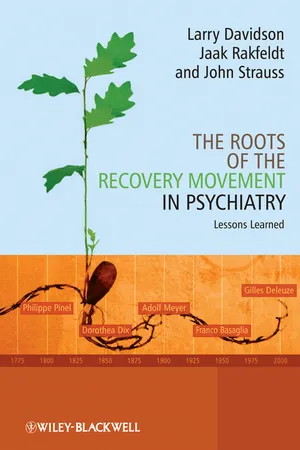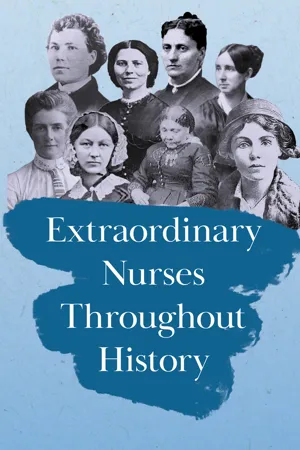Dorothea Dix
Dorothea Dix was a 19th-century activist who advocated for the humane treatment of individuals with mental illness. She played a significant role in the establishment of mental asylums and lobbied for improved conditions for the mentally ill. Dix's efforts contributed to the reform of mental health care in the United States and raised awareness about the importance of compassionate treatment for individuals with psychological disorders.
5 Key excerpts on "Dorothea Dix"
- eBook - ePub
The Roots of the Recovery Movement in Psychiatry
Lessons Learned
- Larry Davidson, Jaak Rakfeldt, John Strauss(Authors)
- 2011(Publication Date)
- Wiley(Publisher)
...3 Reciprocity in Community-based Care 3.1 The advocacy of Dorothea Dix It was at the height of the enthusiasm for moral treatment and prior to the wholesale ‘dumping’ of the elderly, the poor and immigrants into mental hospitals that Dorothea Dix entered the scene. Her intercession at this time in history is instructive for us on several scores, even as an example of the unintended adverse consequences of humane and progressive social policies. Given her own life experience, her single-minded dedication to the cause of securing appropriate care and treatment for individuals with mental illnesses and her impassioned advocacy on their behalf, it would be ungenerous not to include Dix in a book on the conceptual roots of the recovery movement. She represented at the time, and continues to represent, an important and compassionate point of view that must be addressed in current debates about mental health policy. Even if we do not wish to return to the days of large, custodial mental hospitals, we are still faced with the challenge of what to do with and for individuals who do not think they need, or who do not willingly seek or accept, care on their own. A little background about Dix’s life and her work provides a useful context for such a discussion (Tiffany, 1890; Marshall, 1937; Browne, 1969; Greenstone, 1979; Gollaher, 1995; Brown, 1998). Dorothea Dix was born the year after the publication of Pinel’s Treatise on Insanity. By all accounts, her childhood was not a happy one, running away from her parents’ home in Maine when she was only 12 years old to live with her paternal grandmother and then with an aunt in Massachusetts. Showing an impressive degree of determination, leadership and energy that would last for most of her life, she opened two schools by the age of 20...
- eBook - ePub
Madness
American Protestant Responses to Mental Illness
- Heather H. Vacek(Author)
- 2015(Publication Date)
- Baylor University Press(Publisher)
...Beyond providing care for family members and neighbors, believers felt called to ensure help for all in need. Churchgoers made provisions for that work in a variety of ways. They formed benevolence societies with goals of abolishing slavery, curbing intemperate drinking, and distributing Bibles. 4 They took matters into their own hands and provided care for the ailing and destitute. Often, they enlisted governmental resources to aid their Christian mission to ameliorate suffering. Dix pioneered the final approach, relying not only on her own determined discipline but also on the sympathies of fellow believers to procure funding for mental institutions. Dix demonstrated that not all Protestants that attended to mental illness were physicians or clergymen. She responded to suffering by claiming authority from her identity as Christian, called to help fulfill God’s mission in the world. Her example, visible to men and women around the nation, helped cement the conviction that faith demanded individual public action to alleviate suffering. The tenacious reformer operated with a new sort of authority, a moral authority rooted in her Protestant faith. 5 Dix’s career as a social activist did not begin until she was forty-one years old, and yet she appeared indefatigable in the four decades that followed. A woman with humble New England beginnings, she transformed into a renowned and respected advocate for the country’s insane. She crisscrossed the nation inspecting public institutions. She dined and vacationed with intellectual and social elites. A Protestant, she garnered the attention of Pope Pius IX with her work. An American living before the enfranchisement of woman, she commanded notice from state and national politicians. As her public career blossomed, the Presbyterian minister Theodore L...
- Amy E. Wenzel(Author)
- 2017(Publication Date)
- SAGE Publications, Inc(Publisher)
...Although these methods are considered unethical by current American standards, in the late 18th and early 19th centuries Rush was praised for his contribution to the field of psychopathology. Age of Asylums During the 17th century, the development of asylums to care for those with mental health disorders was seen in many societies. Prior to this time, there had been institutions such as St. Mary of Bethlehem in London (popularly known as “Bedlam”) and the Hotel-Dieu in Paris, which opened in the 13th century. The 14th century also saw the development of “madhouses”; it was not until 1838, however, that a law was passed in France creating a national system of asylums. The providers of treatment for those in these asylums were a mix of secular liberals and Catholic nuns. In 1845, England passed a similar law to France’s; prior to this law, there was already the Association of Medical Officers of Asylums and Hospitals for the Insane, founded in 1841. In the United States, Dorothea Dix (1802–1887) campaigned for states to take responsibility for their citizens with mental health disorders by building and staffing asylums for their care. Although these Western countries were progressing toward more humane treatment for those with mental health disorders, there were many practices that, by today’s standards, are considered unethical treatment. Nineteenth Century: A Turning Point in Treatment The late 19th century was a turning point for the treatment of mental health disorders. In this period, William Griesinger (1817–1868), the director of psychiatry in Berlin’s Charité hospital, published Mental Pathology and Therapeutics. This particularly influential work set the stage for psychodynamic psychiatrists and psychologists. Griesinger is known for his view that mental health disorders are brain diseases...
- eBook - ePub
Extraordinary Nurses Throughout History
In Honour of Florence Nightingale
- Various(Author)
- 2020(Publication Date)
- Brilliant Women - Read & Co.(Publisher)
...Dorothea Dix 1802 — 1887 DOROTHEA L. DIX By Frances E. Willard and Mary A. Livermore Philanthropist and army nurse, born in Hampden, Maine, in 1802, and died in Trenton, New Jersey, 7th July, 1887. Her father, a Boston merchant, died in 1821. and Dorothea started a school for girls in that city. She became interested in the convicts in State prisons, visited them and worked to secure better treatment for them. Her school work and her philanthropic labors broke down her health in 1833, when she was prostrated by haemorrhages from the lungs. Having inherited a small fortune, she went to Europe for her health. The voyage benefited her, and in 1837 she returned to Boston and renewed her labors for the paupers, lunatics and prisoners, in which she was assisted by Rev. Dr. Channing. The condition of affairs in the East Cambridge almshouse aroused her indignation, and she set about to secure an improvement in the methods of caring for the insane paupers. She visited every State east of the Rocky Mountains, working with the legislatures to provide for the relief of the wretched inmates of the jails, prisons, alms-houses and asylums. In Indiana, Illinois, North Carolina, New York and Pennsylvania she was especially successful in securing legislative action to establish State lunatic asylums. In January, 1843, she addressed to the Legislature of Massachusetts a memorial in behalf of the "insane persons confined within this Commonwealth, in cages, closets, cellars, stalls, pens; chained, naked. beaten with rods, and lashed into obedience!" The result was a great improvement. In twenty States she visited asylums, pointed out abuses and suggested reforms. She succeeded in founding thirty-two asylums in the United States, in Canada, Nova Scotia, Guernsey and Rome. She secured the changing of the lunacy laws of Scotland. She went to Europe, and there she visited Paris, Florence, Rome, Athens, Constantinople, Vienna, Moscow and St...
- eBook - ePub
The Lady and the President
The Letters of Dorothea Dix and Millard Fillmore
- Charles M. Snyder(Author)
- 2021(Publication Date)
- The University Press of Kentucky(Publisher)
...Doctor Samuel Gridley Howe, a Boston philanthropist, who had offered his services to the Greeks in their struggle for independence and pioneered in the education of the blind, corroborated her evaluation of the Cambridge jail, and led the drive for passage in the legislature. Horace Mann, who had introduced bills to provide more enlightened care for the insane in the legislature thirteen years earlier, came to her aid, as did Doctor Channing during his last illness and the young and brilliant Charles Sumner. Behind the scenes Dorothea counseled the legislators, demonstrating a quiet confidence and persuasiveness which she had not revealed earlier. The result was a decisive victory, and an appropriation to enlarge the already existing mental hospital at Worcester. It became the first monument to her crusade. It has not been ascertained whether Dorothea’s special concern for the plight of the insane predated her inspection of the East Cambridge House of Correction or if she was aware of newer therapies. It can be assumed, however, that she was conversant with the work of Doctor Philippe Pinel in Paris and William Tuke at York. She may have met the latter’s son Richard during her visit at the Rathbones. Pinel’s publication of a treatise on mental disease in 1791 marked the beginning of a rational and scientific approach to the treatment of the insane. He advocated a humane system, the removal of restraints from the victims, and occupational therapy. His treatise became a guidebook for reformers in Europe and America. Shortly after the publication of this book, William Tuke established the York Retreat, applying the principles of Pinel to provide better care for fellow Friends who were mentally sick. It became a model for other institutions and a laboratory where students might observe the new therapy in operation. Whatever her deficiencies may have been at the outset, Dorothea became an advocate of Pinel and Tuke and was soon in contact with American leaders...




